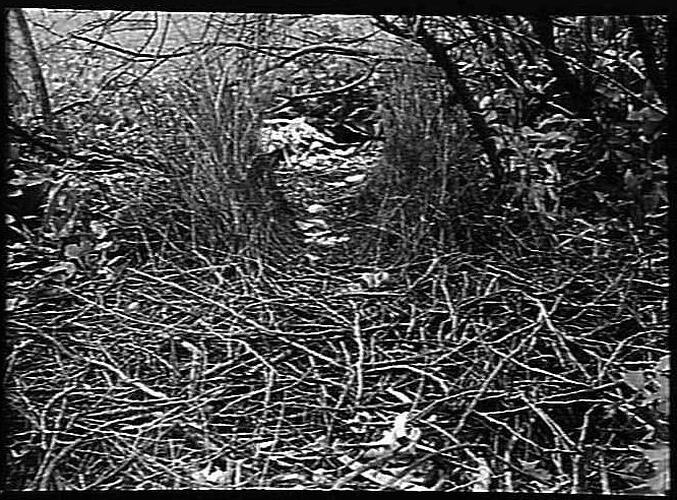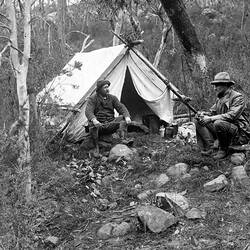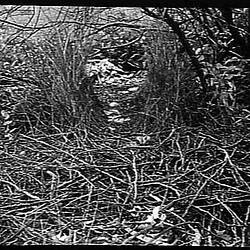SATIN BOWER BIRD (Ptilonorhynchus Violaceus, Veillot - 276)
Geographical Distribution - Queensland, New South Wales and Victoria.
Nest - Open, shallow; somewhat loosely constructed of twigs; lined inside with leaves (Eucalyptus) and placed in a scrubby bush or tree, at a height varying from about ten to thirty feet from the ground. Dimensions over all, diameter 7 or 8 inches by 5 inches in depth. (See illustration).
Eggs - Clutch, two to three; shape true oval; shell moderately fine in texture; surface glossy; colour varies from dark-cream to dirty-yellow, irregularly blotched and spotted with umber, cinnamon-brown, and a few purplish markings. In some specimens the blotches are very bold, with the markings under the surface of the shell of a bluish-black shade. Occasionally there is a type with a lighter or paler coloured ground and smaller-sized markings. Others again have the markings more in the form of hieroglyphics. Dimensions in inches of a typical clutch: (1) 1.76 x 1.l9, (2) 1.74 x 1.17. (Plate 9). Except for their larger size, the eggs in colour and character much resemble those of the Oriole (Mimeta viridis).
Observations - the male is especially beautiful by reason of his lustrous blue-black coat and lovely violet eyes, is an inhabitant of the forests, more particularly of the coastal region, of Eastern Australia, from Northern Queensland down to the Cape Otway forest, Victoria.
Some seasons Satin Birds are very destructive in the gardens and orchards, eating clover, especially the flowers, English grass, cabbages down to the very root, and fruit. The late W. B. Bailey, Pimpama Nurseries, South Queensland, informed me of an instance in which he had about three acres of mandarin oranges stripped in a week. The birds are also fond of sweet potato tubers. I noticed at Mr. Bailey's residence a very handsome male bird which he had in captivity. It was in its youthful coat of mottled-green when he first obtained it. It is interesting to learn that this bird did not don its full livery of blue-black till the fourth year.* The bird was an excellent mimic, could talk, and imitate well the meowing of a cat.
It is somewhat remarkable that, notwithstanding the Satin Birds are plentiful locally, the eggs are exceedingly rare in collections. On the 23rd November, 1883, my friend Mr. Lindsay Clark found, near the Bass River, Western Port, a nest of the Satin Bird containing a rare prize: a pair of fresh eggs. Mr. Clark described the nest as being placed about twelve feet from the ground, in a scrubby bush, loosely constructed of twigs, &c., and lined with leaves; on being removed from its position it fell to pieces. A most remarkable instance, and one fortunate for myself, happened the following season. Mr. Clark went Mutton Bird (Puffinus tenuirostris) egging on Phillip Island, when it occurred to him to visit the mainland again in the neighbourhood of his Satin Bird's nest of the previous season. The result was that he found another pair of eggs, which are now in my collection.
I never enjoyed the opportunity of taking a nest of the Satin Bird, but at Christmas-tide, 1884, I saw a perfect bower on the north shore of Lake King, Gippsland. The structure was situated in a cleared space upon the ground, amongst some bracken in open forest. The cleared space was twenty-six inches across, the bower or avenue being in the centre of this space. The two parallel tapering walls of twigs were about twelve inches high, by a breadth of ten inches, and were six inches apart. The walls were somewhat curved, arching towards the top. The chief decorations within the bower, and round about, were the gay feathers of the Crimson Parrakeet (Platycercus elegans).
It is stated that the first bower of the Satin Bird that Gould saw was in the Sydney Museum. He succeeded in conveying it to England. The illustration I have given is from a picture by Mr. D. Le Souëf, taken at Mallacoota Inlet.
The Satin Bird's eggs which Dr. Ramsay described in the Proceedings of the Zoological Society (1875) were of an abnormal type, if referable to that bird at all, hence his excuse for redescribing (and rightly so) two well-authenticated sets collected by Mr. Ralph Hargrave, at Wattamola, New South Wales. Dr. A. E. Cox, Sydney, informed me that about the middle of October, 1876, at Mittagong, New South Wales, he found a nest of the Satin Bird situated on the tope of a tea-tree (Melaleuca) stump, containing two eggs which were nearly incubated.
From Mr. K. Broadbent's interesting articles on the 'Cardwell Birds', I take this extract: - 'The Satin Bower Bird (ptilonorhynchus violaceus) was observed at the Herbert River Gorge, and quite commonly in the Herberton scrubs. In the latter locality it occurred in company with the Spotted Cat Bird (Ælurodus maculosus), and the Tooth-billed Bower Bird (Tectonornis dentirostris), and Newton's Bower Bird (Prionodura newtoniana); in fact I have seen all these four species feeding in the same tree. These Satin Birds, as they are more popularly designated, may be often met with during the month of May in the open, along the edges of the scrubs, feeding upon the tops of young ferns. I have seen flocks of two hundred or more, composed in large proportions of plain-coloured mottled birds, with about ten or twelve dark or deep blue-coloured individuals amongst them.'
Regarding this Bower Bird in Southern Queensland, I take from Mr. Hermann Lau's MS the following:- 'Satin Bird - The sea-coast scrubs are its haunts. Now and again it comes out to the open forest to feed upon the berries of the mistletoe, or on the figs in the gardens. Its agreeable note is a clear whistle from tenor down to bass. While the male bird is clad in a beautiful shining coat of dark-blue, with eyes and base of bill to match, the female has only a simple (olive-green) attire. The females, with probably immature males, have been seen in flocks far from their summer abode.'
'Before nesting begins, the birds build up a play-ground (bower). The finest bowers are nearly in all cases on the sunny side of a lying log, the ground being strewn with moss, flowers, yellow and blue Lory Parrots' feathers, small bones, and snail-houses, for about a yard in diameter. In the middle is erected a bower about eighteen inches in height. When completed, several birds of both sexes run round and through the archway or avenue, picking up, in their joy, some of the nesting (? bower) materials and tossing them about, and we may guess, in their own way, choose partners.
'As I was watching one day at Cunningham Gap, a fine male bird with a withered fig-leaf in its bill, turning it over, became a prey to me. Half a mile away from the spot I found the nest (but no eggs) ten feet from the ground, in a small scrub tree. The nest was made of dry sticks, and lined with dry leaves, and was rather shallow. Later, when residing in the Bunya Mountains, I had the satisfaction of getting again a nest with two eggs (usual complement), ten feet from the ground.' Date, January, 1887.
I conclude with a brief account of a successful nesting outing that Mr. S. W. Jackson enjoyed amongst these fascinating birds. The notes, which Mr. Jackson was kind enough to write specially for me, are as follow: -
On December 23rd, 1896, I started from South Grafton and proceeded on my bicycle towards Cloud's Creek, some fifty-nine miles distant, in hopes of finding some good eggs in the scrubs in those parts. However, on reaching my destination, after a good day's riding on my machine, which was heavily loaded with tent, camera, rations, &c., I pitched my camp, and afterwards had a stroll among the oak trees (two species of Casuarina). In answer to the cries or calls of the Satin Bower Bird, I walked about fifty yards from my camp, and was forced to stop at an oak tree, my notice being called to a female Bower Bird which flushed out from a cluster of mistletoe, which contained three fresh eggs. The nest was constructed of similar material, &c., to that of the Black-throated Butcher Bird (Cracticus nigrigularis), only lined with leaves of the spotted eucalyptus instead of small twigs.
I carefully emptied the nest of its contents, but unfortunately the nest could not be removed, on account of the sticks of the same being so intermingles with the twigs of the mistletoe, the latter growing on a very thick limb. After making further searches, I succeeded in finding nine more nests, all of which were built in oak trees, and in same position as the first nest found, with the exception that four of them were built in the upright forks of the oaks, and not in the mistletoe as the remaining six were. In the nine nests found there were eggs in four of them, out of which I got one fresh set of two, and a few addled eggs, the balance of the eggs being too far advanced in incubation to be blown. The remaining five nests all contained young birds, covered with down, and in one nest I found one young bird possessing four legs, and I regret I did not keep the curiosity, instead of placing it back into the nest.
'In all, I only procured seven eggs, which varied much in size and colour. Out of the ten nests found, the following is the detailed result: -
1 nest contained set of 3 eggs (fresh)
1 nest contained set of 2 eggs (almost fresh)
1 nest contained set of 1 egg (addled) and 1 bird
4 nests contained set of 3 young birds each
2 nests contained set of 2 eggs each (heavily incubated)
1 nest contained set of 3 eggs (1 addled, 2 heavily incubated)
'The majority of the nests were one hundred or two hundred yards apart, at an elevation of about twenty to thirty feet, and mostly placed near the trunk of the tree, just where the smaller twigs branch off near the topmost part. The birds were very tame, and allowed their nests to be robbed without attempting to attack the intruder.
'I spent four days by myself in this wild bush, away from civilisation, and tried my best to find more nests of the Bower Bird, but only succeeded in finding two old nests (perhaps last season's).
'While I was busily climbing up to one of the Satin Bird's nests, and when nearing the same, I got rather an unexpected shock at finding an iguana (a reptile about three or four feet long) eating, or starting to eat, one of the heavily incubated eggs. The ugly creature, in it sudden amazement, jumped on my head, and then descended to the ground. The feeling to me was very unpleasant, and of rather a rare nature.'
The breeding months extend from October to January.
-----------------------------------* Since this statement was published in the Proceedings of the Royal Physical Society (Edinburgh), Mr. A. A. C. Le Souëf, Director of the Zoological Gardens, Melbourne, has kindly favoured me with the following: - 'I think this par-ticular bird must have been of mature years when Mr. Bailey first got it, as many years ago I caged a number (at least a dozen) of these birds at the gardens here, young green birds, caught at Gembrook, and it was only after the expiration of nearly eight years they began to change colour. I think four or five birds put on the beautiful blue-black plumage, and in a year or two died off. It is, therefore, evident that the birds only come to their full plumage in old age, and that accounts for the fact that in a flock of say one hundred birds, which we often used to see at Gembrook, some years ago, there would be only a very few, hot half-a-dozen black ones among them. They die off shortly after the change.'
# Mr. I. W. De Lany informs me that he has only noticed blue feathers at bowers. His wife, by way of experiment, put out several pieces of coloured wools near the house, and only the blue ones were taken to the bower.
Resources
Transcribed Archibald James Campbell. Nests and Eggs of Australian Birds, including the Geographical Distribution of the Species and Popular Observations Thereon, Pawson & Brailsford, Sheffield, England, 1900, pp. 191-195.
More Information
-
Keywords
-
Authors
-
Contributors
-
Article types


